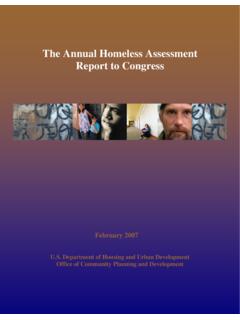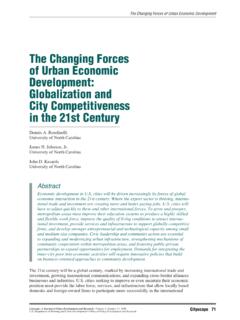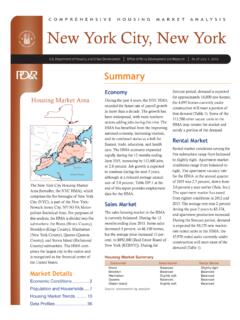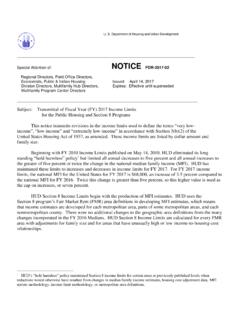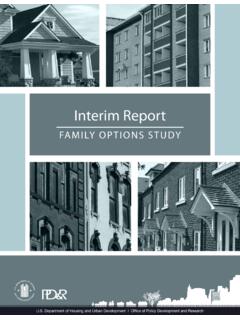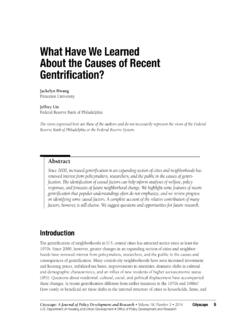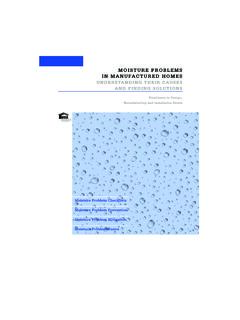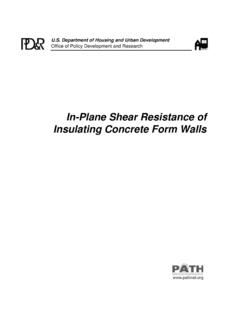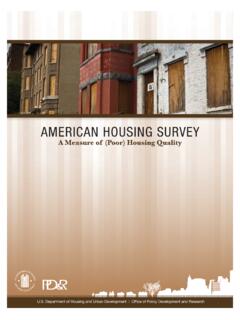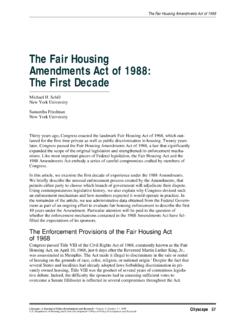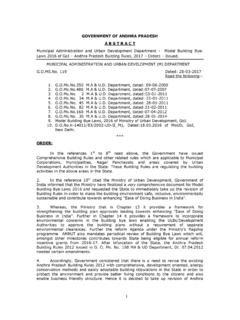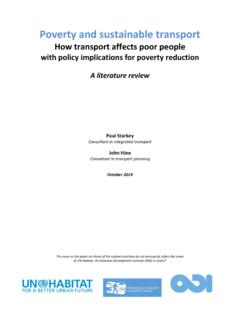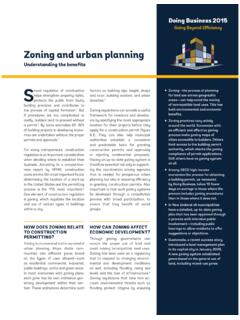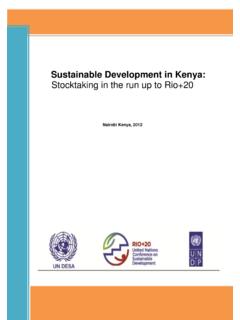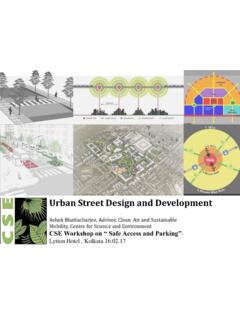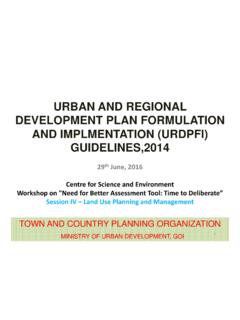Transcription of U.S. Department of Housing and Urban Development Office …
1 Department of Housing and Urban Development Office of Policy Development and Research Visit PD&R s website to find this report and others sponsored by HUD s Office of Policy Development and Research (PD&R). Other services of HUD USER, PD&R s research information service, include listservs, special interest reports, bimonthly publications (best practices, significant studies from other sources), access to public use databases, and a hotline (800-245-2691) for help accessing the information you need. The contents of this report are the views of the contractor and do not necessarily reflect the views or policies of the Department of Housing and Urban Development or the Government. ii PREFACE In 2000, HUD, in recognition that any solution to homelessness must emphasize Housing , targeted its McKinney-Vento Act homeless competitive programs towards Housing activities. This policy decision presumed that mainstream programs such as Medicaid, TANF and General Assistance could pick up the slack produced by the change.
2 This study examines how seven communities sought to improve homeless people s access to mainstream services following this shift away from funding services through the Supportive Housing Program (SHP). By examining the different organizations used and activities undertaken by communities to maximize homeless people s access to mainstream benefits and services, this study provides communities with models and strategies that they can use. It also highlights the limits of what even the most resourceful of communities can do to enhance service and benefit access by homeless families and individuals. Responses to HUD s Policy Shift Of the seven study communities (Albany/Albany County, NY; Albuquerque, NM; Metropolitan Denver, CO; Miami-Dade County, FL; Norfolk, VA; Portland, ME; and Pittsburgh/Allegheny County, PA), six shifted their balance of homeless Housing and service funding from HUD substantially in response to the Department s greater emphasis on Housing . Four of the seven communities more than doubled their receipt of Housing resources (capital and, mostly, rent subsidies) from the SHP between 2001 and 2007.
3 SHP service funding, however, either increased much less than Housing resources over the same time period, or declined. Some communities were able to find additional resources to support new services or to substitute for lost funding, but others have been forced either to cut back or to forego new services. Improving Access to Mainstream Services The study identifies three groups of barriers to access and three categories of mechanisms communities could use to reduce these barriers. Structural barriers are obstacles that prevent an eligible person from getting available benefits, such as where programs are located, how they are organized, or what they require of applicants. In each site, structural barriers represented both a significant frustration and a primary target of mechanisms for increased access. Homeless individuals and families face unique structural obstacles because, by definition or circumstance, they do not have the ready means of communication, transportation, regular address, and documentation that most mainstream programs require.
4 Smoothing mechanisms reduce structural barriers and address problems at the street level. Such mechanisms include providing transportation; conducting outreach to the streets, feeding programs, shelters, and other homeless facilities; co-locating mainstream eligibility workers in homeless assistance programs; creating one-stop intake centers for homeless people; providing multilingual services; and improving communications among homeless iiiassistance workers and mainstream agency eligibility workers. Denver s Road Home program focused on organizing all existing outreach programs, expanding some along the way. It pays for 20 outreach workers, including two in the police Department . It also facilitates relations of the outreach teams with mainstream agencies. Chronic homelessness was down 36 percent in the program s first three years. Capacity barriers result from the inadequacy of available resources; funding may be finite or capped. While harder to reduce than structural barriers, most study communities managed to acquire new resources (usually state funds) to expand capacity for at least one mainstream benefit or service.
5 Capacity barriers are often addressed through expanding mechanisms, which involve increasing overall capacity via the commitment of additional resources, including raising funds from state or local sources or allocating other federal funding. Miami-Dade County s Homeless Trust began in 1993, when the county imposed a tax on food and beverages served in many restaurants and bars to provide resources to address homelessness. The Trust manages the tax funds generated as well as all other public homelessness resources, centralizing the county s homelessness organizing structure. Eligibility barriers are program rules that establish the criteria for who may receive the benefit as well as time limits on receipt. Many eligibility restrictions are embedded in federal policy and cannot easily be influenced at the local level. Changing mechanisms alter eligibility but not overall capacity. This could involve, for example, establishing a priority for homeless households within local rent subsidy programs.
6 The city Housing authority in Pittsburgh, through the flexibility it had from the Moving to Work demonstration program, adopted a felony rehabilitation clause to allow ex-offenders access to federal rent subsidies and public Housing if they could demonstrate rehabilitation. While smoothing mechanisms were the most common approach used by communities to overcome barriers, the study communities were able to change eligibility and/or expand capacity for non-entitlement services through significant new commitments of local resources, along with occasional use of state resources. Improvements in Homeless People s Receipt of Benefits Using 2007 Annual Performance Report data from the four study communities for which it was available, the study finds evidence that people exiting HUD-funded programs were likely to be connected to mainstream benefits at rates for 2007 that exceeded national rates for that year. The highest rates of enrollment were for food stamps 40 percent or more in three communities, compared to the national average of 25 percent.
7 This high rate reflects that basic eligibility is broadest for food stamps, but also suggests that many barriers to access have been reduced through structural mechanisms. In the two communities that had General Assistance programs, participation rates at program exit were 18 and 22 percent, compared to the national average of 6 percent. iv SSI/SSDI access rates varied highly at the four sites, as did access to TANF. Rates of Medicaid enrollment did not differ from national rates. The study also examined data from the Substance Abuse and Mental Health Services Administration (SAMHSA) Homeless Families study, to gain additional information on homeless families receipt of mainstream benefits and services over time. The SAMHSA study families had high rates of participation in Medicaid, food stamps, and TANF. Understanding the Role of Central Organizing Structures The communities in the study who took the most effective steps in overcoming obstacles to benefit access had a strong central organization focused on improving the access of homeless households to mainstream services.
8 This structure enables communication and collaboration to create a coordinated community response. The study concludes that more strongly organized communities have: 1) thought through and put in place a range of mechanisms to improve access; 2) made sure those mechanisms covered the whole community; 3) made more of an impact on how mainstream agencies do business; and 4) significantly increased the degree of coordination and collaboration among homeless assistance providers, among mainstream agencies, and between the two groups. In addition to developing effective, inclusive, and creative organizing structures, communities should look for mechanisms to improve access that show evidence of effectiveness in other communities. This study provides a range of creative mechanisms that they can consider. vACKNOWLEDGMENTS Many people offered their time and expertise to assist us in carrying out this project and completing this report. Most importantly, Paul Dornan and Marina Myhre at the Department of Housing and Urban Development provided extensive guidance throughout the planning and implementation phases, and assisted in the Development of this report through their thoughtful review of its earlier versions.
9 The information in this report is drawn from the experience and knowledge of the front-line staff, supervisors, administrators, and local officials we interviewed at each of the seven study sites. With 20 to 50 interviewees per community, there is not space to thank them individually here. Their names may be found in the community descriptions in Appendix A. The study community site visits would not have been possible without the involvement of our primary local contacts. Each community s contacts helped us identify the aspects of their communities on which we should focus our attention, worked with us to determine the individuals and agencies we needed to visit in their community, facilitated the visits themselves, responded to our requests for clarification following the site visits, and carefully reviewed our site-visit write-ups, ensuring that the information we used for the report accurately reflects the communities and their service systems. Our primary contacts are: Miami - David Raymond of the Miami-Dade County Homeless Trust Denver - Jamie Van Leeuwen of Denver s Road Home and Jerene Peterson of the Denver Department of Human Services Pittsburgh - Michael Lindsay and Reginald Young, both of the Allegheny County Department of Human Services Albuquerque - Lisa LaBrecque of the New Mexico Coalition to End Homelessness Albany - Linda Glassman, formerly of CARES, and Linda Doyle of the Albany County Department of Social Services Norfolk - Katie Kitchin, formerly of the Norfolk Office to End Homelessness Portland - Robert Duranleau of the Portland Health and Human Services Department and Jon Bradley of Preble Street The analysis reported in Chapter 4 is based upon data collected in a SAMHSA-sponsored study of homeless families.
10 Principal investigators for the individual projects were Linda Frisman (CT), James Galloway (NC), John Hornik (NY), Gary Morse (MO), JoAnn Sacks (PA), Judith Samuels (NY), Michael Shafer (AZ), and Linda Weinreb (MA). Table of Contents viTABLE OF CONTENTS PREFACE ..iiACKNOWLEDGMENTS ..vTABLE OF vi EXECUTIVE SUMMARY .. x The Core Study Questions .. x The Issue of Access to Public xi to HUD s Policy Shift .. xiii Major xv Categorizing Barriers to xv Categorizing Mechanisms to Overcome Barriers .. xvii Documenting Improvements in Homeless People s Receipt of Benefits .. xix Understanding the Role of Central Organizing Structures .. xxiv xxviCHAPTER 1: INTRODUCTION .. 1 Existing Research: Access to Mainstream Services and Benefits for Homeless 2 What Programs Exist to Meet Basic Needs? .. 3 To What Extent Do Homeless People Access Mainstream Services?.. 3 What Factors Impede Access? .. 4 Mechanisms and Strategies to Facilitate Access .. 5 Assuring that Policy Changes Get to the Streets.
